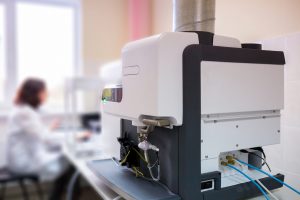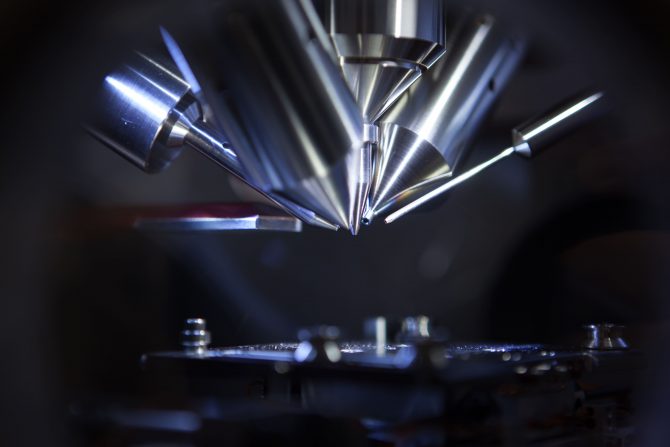Let’s say you need to find out the chemical composition of a certain liquid or solid sample — for example, to detect impurities. How do you determine this in the quickest, most efficient, and most accurate way?
The answer is spectroscopy — a chemical analysis method that relies on how different chemical elements interact with light and other types of electromagnetic radiation to determine what the elements are.
The key instrument used in spectroscopy is a spectrometer — a simple yet complex machine. But how exactly does it work?
In this article, we will answer this question and more, to help you determine what spectroscopy solution best fits your chemical testing needs.
Optimize Your Manufacturing Processes with Spectroscopy. Get in Touch
What is a Spectrometer?
Formally speaking, a spectrometer is a scientific device that can separate a certain physical property (such as wavelength or mass) into individual spectra or ranges and measure them.
However, colloquially, the term “spectrometer” usually refers to a few specific types of chemical analysis tools that measure how a certain kind of electromagnetic radiation interacts with matter at different points of the electromagnetic spectrum.
To put it simply, you can use a spectroscope to establish whether a certain chemical element is present in (or absent from) the sample you’re analyzing. All you need to know to achieve this is how different chemical elements behave when exposed to electromagnetic radiation within a specific spectrum — be it x-rays, infrared light, or visible light.
What Are the Different Types of Spectrometers?
Even though there are many different scientific tools that qualify as spectroscopes, the devices that are commonly and colloquially referred to as spectroscopes fall into one of the following three categories.
#1. Mass Spectrometers
Mass spectrometers determine the chemical composition of a sample by measuring, as the name suggests, the mass of the molecules that make up the sample.
The key concept behind the functionality of mass spectrometers is the mass-to-charge ratio — the relation between a particle’s mass (essentially, quantity) and its electric charge. In a mass spectrometer, the mass-to-charge ratio of the particles that make up the sample is measured through the process of ionization — bombarding the sample with negatively charged electrons.
This causes the atoms and molecules in the sample to convert into ions — electrically charged particles which have a higher (or lower) number of electrons than they normally should. Once these particles are charged in the ionizer, they begin dissociating or fragmenting into even smaller particles, with unique mass and electric charge signatures.
The mass spectrometer detects this process of fragmentation and plots the results in a chart called the mass spectrum. And because different chemical elements, along with the particles they’re made of, have unique mass spectrums, this makes it possible to determine the precise mass and electrical charge of the particles in the sample.
Consequently, this allows you to determine the molecular structure of the sample and, finally, its chemical composition.
If all this sounds complex, that’s because it is — mass spectrometry is a very sensitive, yet very sophisticated chemical analysis technique. As a result, it’s mostly utilized in scientific experiments and analytical testing, such as isotope dating and tracing.
#2. Nuclear Magnetic Resonance (NMR) Spectrometers
Nuclear magnetic resonance (NMR) spectrometers determine the physical and molecular structure of a sample by measuring how the nuclei of the sample’s atoms behave, when exposed to a strong magnetic field.
As you might have already guessed from the name, NMR spectrometers are powered by a physical phenomenon known as nuclear magnetic resonance. A nuclear magnetic resonance occurs when an atom’s nucleus with a ½ spin — the bundle of neutrons and protons at the atom’s center — is placed in a strong magnetic field, thus splitting the energy levels of the spin component into aligned and anti-aligned levels, which is probed by a weaker, oscillating magnetic field, typically in the radio frequency range.
If the energy of this radio frequency photon matches the energy of the nucleus’ split spin state, the nucleus absorbs this photon — and emits an electromagnetic signal as the state relaxes to equilibrium.
NMR spectroscopy is useful when the nucleus of interest has a spin of ½, which many atoms have (for example, hydrogen and certain carbon atoms). In addition, the spectra obtained from these nuclei are sensitive reporters of the local environment of atoms in the vicinity of the NMR active atoms and can provide valuable insight into the structure of the molecule of interest.
NMR spectrometers are most commonly utilized in organic chemistry to identify specific organic molecules or compounds in a sample, such as proteins. However, because NMR spectrometers are typically very large and expensive, applications are usually limited to scientific research and not commercial purposes.
#3. Optical Spectrometers
Optical spectrometers measure the light absorbed by a sample within a certain portion of the electromagnetic spectrum. This information can be used to determine the sample’s chemical composition.
Optical spectrometers, also known as spectrophotometers, are the most popular type of spectroscopes. In fact, they are so widely used in both scientific and commercial applications that the word “spectrometer” most commonly refers to a type of optical spectrophotometer.
However, “optical spectrometer” is an umbrella term for a large variety of devices. The three most popular sub-categories of optical spectrophotometers are:
- Ultraviolet-visible (UV-Vis) spectrometers, which is used to measure how a sample absorbs ultraviolet-visible light to determine the chemical composition of the sample
- Near-infrared spectrometers, which is used to measure the near-infrared light absorption of a sample and to then determine the sample’s chemical composition
- Raman spectrometers, which measure the Raman scattering of photons in a sample to determine its molecular structure
What all types of optical spectrophotometers have in common with each other is that different portions of the electromagnetic spectrum can be used to quantitively determine the chemical identity of a sample, whether is electronic spectroscopy via UV/Vis, or vibration spectroscopy via NIR and Raman.
For example, UV-Vis spectrophotometers detect the exact portion of the electromagnetic spectrum at which the sample absorbs light. By correlating the wavelength spectrum of the light that has been absorbed, by the sample with the known absorption spectra of different chemical elements, a UV-Vis spectrometer can be used to establish the presence of a certain chemical compound in a solution.
As we mentioned, optical spectrophotometers are the most widely used type of spectroscopes in both scientific and commercial scenarios, due to their relative affordability, versatility, and accuracy.
To answer one of the key questions we posed early on — an optical spectrometer is the best solution for your chemical testing needs. To elaborate, we’ll focus the rest of this article on how optical spectroscopes in particular work and what their benefits entail.
Configure the Right Spectrophotometer for Your Next Chemical Analysis. Get in Touch
How Does an Optical Spectrometer Work?
Even though the different kinds of optical spectrophotometers rely on different physics phenomena and function differently, the basic operating principle behind all of them is the same.
All-optical spectroscope systems send light through the sample, receive it, and interpret how it was affected by the sample, to determine the sample’s chemical composition.
As a result, there are several components you will find in any kind of optical spectroscope:
- A source of light, which is usually a lamp that emits the light that passes through the sample. The exact type of light source depends on the portion of the electromagnetic spectrum in which the spectroscope operates. For example, UV-Vis spectrometers typically use a xenon lamp, which is capable of emitting both ultraviolet and visible light. On the other hand, NIR spectrometers typically feature tungsten-halogen lamps, because they cover the entire near-infrared light range. Finally, Raman spectrometers use lasers because they offer the high intensity necessary to drive Raman scattering.
- A wavelength selector, which allows for the light to be split into individual wavelengths. In the case of visible light, this means individual colors. This diffraction of light is essential to the optical spectroscopy process, as it enables the spectroscope to measure how the sample interacts with light of specific wavelengths. The most basic and fundamental type of a wavelength selector is a prism — the same as the one discovered by Sir Isaac Newton and the one featured on the cover of Pink Floyd’s The Dark Side of the Moon. However, most modern spectrophotometers rely on a set of mirrors with a diffraction grating instead, as it allows for a more precise separation of light.
- A photodetector, which receives and interprets the light that has passed through the sample. The photodetectors in most optical spectrophotometers are similar to those found in digital cameras, capable of simultaneously absorbing the light across the entirety of its electromagnetic spectrum. This type of photodetector is also known as a charge-coupled device (CCD), which consists of an array of light-sensitive sensors. These sensors capture the light, process it, and enable the device to visualize its behavior as a graph or a chart.

What Is a Spectrometer Used For?
Even though optical spectrophotometers can be very helpful in scientific experiments, they are most famously used in manufacturing as a quality control measure.
Due to their capability to determine the chemical composition of a sample quickly and accurately, optical spectrophotometers are especially helpful at determining the presence of impurities or foreign elements in a solution.
However, the applications of these devices do not end there. Here are some of the industries that heavily rely on optical spectroscopesf and what they rely on them for:
- Petrochemistry: Near-infrared spectroscopy is widely used in petrochemistry to determine the octane number of gasoline. That’s because the octane number is determined by the concentration of certain hydrocarbon and organic compounds in the fuel, which NIR spectrometers are particularly sensitive to.
- Food and beverage manufacturing: Optical spectrophotometers are commonly used in food and beverage manufacturing as quality control tools. They help ensure that the final product is safe to consume and that the concentrations of certain components within the product (such as macronutrients) fit the legislative and industry requirements. For example, UV-Vis spectroscopy is commonly used to measure the concentration of caffeine in caffeinated beverages. Meanwhile, the organic compound-friendly NIR spectroscopy is used to measure the amount of fat, protein, carbohydrates, and other essential nutrients in food, without disturbing the final packaging.
- Pharmaceutical manufacturing: Optical spectroscopy and Raman spectroscopy in particular are widely used in pharmaceutical manufacturing to monitor the concentration of active pharmaceutical ingredients (APIs) in drugs. Because Raman spectrometers can be very compact and mobile, they allow for the testing to happen in situ using the final product, which can save a lot of time and effort when ensuring drug quality.

What Are the Benefits of Spectrometer Analysis?
Just like the operating principles and applications, the benefits of spectrometer analysis carry over from one type of optical spectrometer to another. Here are some of the key advantages that optical spectrometers have in chemical analysis:
- Non-destructive testing: Optical spectroscopy is non-destructive in the sense that the sample can be used as is, without having to create a solution or alter the product that’s being tested in any way. This makes optical spectroscopy very cost-effective, especially if the sample that needs to be analyzed is scarce or valuable.
- High testing speed, accuracy, and sensitivity: The process of performing an optical spectroscopic analysis takes as short as a few milliseconds and yields highly accurate results. In fact, most optical spectrometers can detect even the smallest traces of a certain chemical element in a sample, which makes them uncompromising quality control tools.
- Ease of use and reliability: Most optical spectrometers do not require any highly specialized training to be operated. These devices are highly automated and user-friendly, which greatly reduces the possibility of human error during the testing process and ensures accuracy during each individual analysis.
Wrapping Up Spectrometers
Even though there are many different types of spectrometers used for both scientific and commercial chemical testing purposes, the most common variant is the optical spectrophotometer. These analytical devices measure how light of a certain wavelength — from near-infrared to ultraviolet — interacts with a sample to determine the sample’s exact chemical composition.
The three most common varieties of optical spectroscopes are Ultralight-Visible (UV-Vis), near-infrared and Raman spectrometers. While the three varieties differ in terms of the science behind them, they are very similar in terms of construction, applications, and benefits.
tec5USA offers all three varieties of optical spectrophotometers, designed for uncompromising performance even in the harshest industrial conditions. From petrochemistry to food and beverage manufacturing, our optical spectrophotometers yield quick and accurate results in all chemical testing scenarios.
Explore our portfolio and discover the right chemical analysis tool for your needs!




